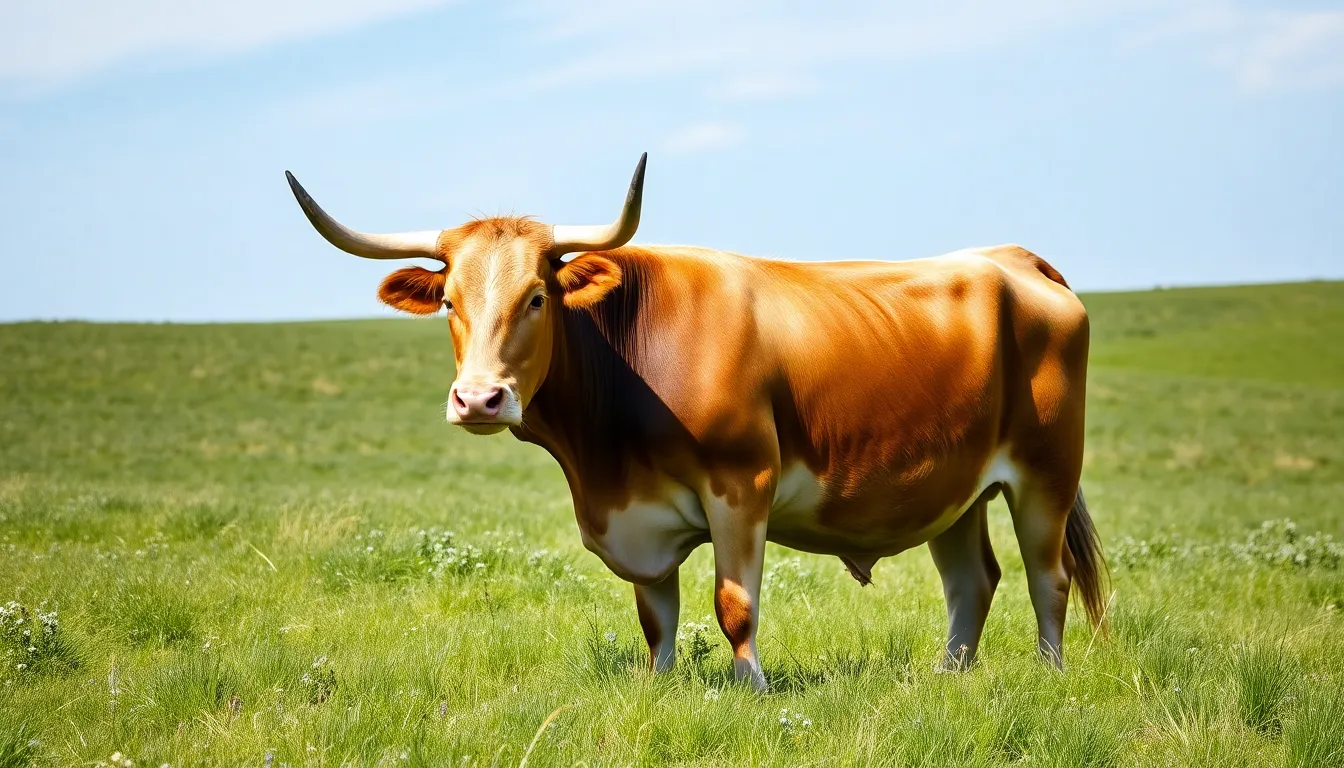When you think of cows, you might picture those gentle giants grazing peacefully in a field. But wait—do female cows have horns? This curious question often leaves people scratching their heads and wondering if they missed a memo on bovine biology.
Believe it or not, female cows can indeed have horns, and they might just be the unsung heroes of the pasture. While many breeds are naturally polled—meaning they lack horns—others sport impressive sets that could rival a rodeo champion. So, saddle up and join the adventure as we dive into the fascinating world of female cows and their horned counterparts. Who knew bovine anatomy could be so exciting?
Table of Contents
ToggleUnderstanding Cow Anatomy
Female cows exhibit diverse anatomical features, including the presence of horns. While some breeds are polled and lack horns, others possess them as part of their natural anatomy.
Female Cow Anatomy
Female cows possess unique structures that differentiate them from other animals. Body shape varies across breeds, with some exhibiting a more robust frame than others. A typical female cow, or heifer, has an udder, which plays a key role in lactation. Reproductive organs include a uterus and ovaries, essential for calf development. Four stomach compartments support efficient digestion, allowing them to break down tough plant materials. Each anatomical feature contributes to their overall health and productivity.
Horn Development in Cows
Horn development occurs in both male and female cows, though not in all breeds. Genetic factors influence horn presence, with some breeds specifically bred to be polled. Hormones play a crucial role in the growth process, particularly during early development. Most horns emerge between six months and two years of age, varying in size and shape based on breed. Environmental factors, such as nutrition and health, also impact horn development. Understanding these factors aids in managing cattle effectively.
Types of Cattle Breeds

Cattle breeds vary significantly, with some known for their horns and others for being polled. Understanding these characteristics is essential for discerning the anatomy and care of female cows.
Horned Breeds
Many breeds exhibit prominent horns. Examples include the Hereford and the Longhorn, both famed for their impressive horn structures. Female animals in these breeds often possess horns just like their male counterparts. Horn development in these breeds can accentuate during growth phases, typically developing between six months and two years. The presence of horns can serve various purposes, including defense against predators and establishing dominance within herds.
Polled Breeds
Conversely, polled breeds lack horns entirely. Breeds such as Angus and Shorthorn are well-known for their hornless characteristics. This genetic trait simplifies management, reducing the risk of injuries among cattle and handlers. Polled animals represent a growing preference among farmers who prioritize animal safety and ease of care. Genetic selection practices help maintain this polled trait, ensuring future generations of cattle retain hornless features.
The Genetics of Horns
Genetics play a key role in whether female cows can develop horns. Understanding the genetic makeup of cattle helps clarify this intriguing aspect of bovine anatomy.
Horned vs. Polled Genetics
Cattle breeds exhibit two primary genetic types: horned and polled. Horned breeds, such as Hereford and Longhorn, possess genes that enable horn growth. In contrast, polled breeds, like Angus and Shorthorn, carry a genetic mutation that prevents horn formation. Selecting for these traits influences cattle breeding decisions and management practices significantly. Farmers increasingly prefer polled animals to lower injury risks and ease handling. As a result, genetic testing becomes essential for effective breeding outcomes.
Role of Dominant and Recessive Traits
Dominant and recessive traits determine whether a cow has horns. The horned condition follows a dominant inheritance pattern, meaning only one parent must possess the horned gene for offspring to inherit this trait. Polled characteristics are typically recessive, requiring both parents to pass on the polled gene for a cow to be born without horns. In breeding programs, understanding these patterns enables better predictions of offspring traits. Careful selection can enhance desirable traits in the herd, contributing to overall herd management success.
Reasons for Horn Development
Understanding horn development in female cows requires consideration of several key factors. Both environmental and hormonal influences play significant roles in determining whether or not a cow will develop horns.
Environmental Factors
Nutrition holds a vital position in horn development. Cows receiving a balanced diet rich in minerals, particularly calcium and phosphorus, are more likely to develop robust horns. Additionally, overall health impacts this process; diseases or stress can hinder growth. Adequate space and social interaction within the herd foster better development, as cows thrive in stable environments. Finally, the age of the cow at the time of weaning can affect horn growth. Cows weaned at a later age often show more pronounced horn development compared to those weaned early.
Hormonal Influences
Hormones significantly influence horn development in female cows. Growth hormones and sex hormones contribute to determining whether horns will develop or not. Estrogen, for example, influences the early stages of horn formation. It’s important to note that the body produces these hormones throughout the cow’s life, impacting growth patterns. Genetics plays a role in how sensitive a cow’s body is to these hormones. Breeds known for their horned traits often exhibit a robust response to hormonal cues. Therefore, effective management of hormone levels can enhance horn growth, should the genetics support it.
Can Female Cows Have Horns?
Female cows can indeed possess horns. Some breeds are naturally horned, while others are polled. Understanding this variation provides insight into their diverse biology, which includes specialized structures like udders and digestive systems.
Exploration of Horn Presence in Females
Certain cattle breeds allow for horn growth among females. Breeds such as Longhorn or Hereford exemplify this trait, showcasing their impressive horns. Genetic factors often dictate this characteristic, where female cattle can carry the genes necessary for horn development. It’s noteworthy that many polled females exist, representing a significant genetic adjustment in cattle breeding. Even so, the presence of horns in females reflects an extraordinary adaptation in specific breeds, emphasizing the need for breed awareness among farmers and cattle enthusiasts.
Factors Influencing Horn Growth
Several factors influence horn development in female cows. Genetics plays a primary role, determining whether an individual possesses the traits for horn formation. Nutritional health further impacts growth; a diet supplying minerals like calcium and phosphorus fosters robust horn development. Management practices can also affect horns, as stress or poor health can inhibit growth potential. Hormonal levels directly contribute to horn development, with variations in growth hormones triggering differences in horn size and robustness. Awareness of these factors aids farmers in optimizing horn growth through effective management strategies.
Female cows can indeed have horns depending on their breed and genetic makeup. Understanding the factors that influence horn development is essential for effective cattle management. Farmers can make informed breeding decisions by recognizing the differences between horned and polled breeds. This knowledge not only helps enhance desirable traits but also contributes to the overall health and productivity of the herd. As the agricultural landscape evolves, appreciating the unique anatomical features of female cows remains crucial for optimizing cattle care and maximizing farm success.



